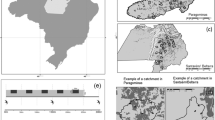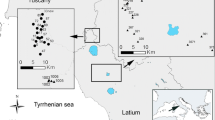Abstract
By comparing results from studies on the response of bird communities to selective logging and fragmentation of tropical moist forest and assessing whether different local faunas are differently affected, this paper examines whether communities in areas of unstable ecoclimatic histories may be more robust to change than those which evolved in places which were paleoecologically stable. Studies on selective logging in Asia and forest fragmentation in Latin America do not confidently demonstrate differences in the resilience of bird communities between stable and unstable areas. However, studies of selective logging and forest fragmentation in Africa give much stronger evidence for differences in fragility of local avifaunas, which correspond to what would be predicted from the paleoecological stability. Unfortunately, the currently available studies do not provide a basis for rigorous testing of the hypothesis. Comparison is constrained by lack of suitable controls, incomparable census methods, inadequate description of the disturbance regimes, and differences in the intensity of disturbance. It is suggested that well coordinated studies in many different areas, with good and standardized documentation of many habitat variables, may have considerable importance.
Similar content being viewed by others
References
Begon, M., Harper, J.L. and Townsend, C.R. (1986) Ecology. Individuals, Populations and Communities, pp. 762–83. Oxford: Blackwell Scientific Publications.
Bierregaard R.O., Jr (1990) Avian communities in the understory of Amazonian forest fragments. In Biogeography and Ecology of Forest Bird Communities (A. Keast, ed.) pp. 333–43. The Hague: SPB Academic Publishing.
Bierregaard R.O., Jr and Lovejoy, T.E. (1988) Birds in Amazonian forest fragments: effects of insularization. In Acta XIX Congressus Internationalis Ornithologici (H. Oullet, ed.) pp. 1564–79. Ottawa: University of Ottawa Press.
Bierregaard R.O., Jr and Lovejoy, T.E. (1989) Effects of forest fragmentation on Amazonian understory bird communities. Acta Amazonica 19, 215–41.
Bierregaard R.O., Jr, Lovejoy, T.E., Kapos, V., Santos, A.A.D. and Hutchings, R.W. (1992) The Biological Dynamics of Tropical Rainforest Fragments. BioScience 42, 859–66.
Cronk, Q.C.B. and Fuller, J.L. (1995) Plant Invaders — the Threat to Natural Ecosystems. London: Chapman and Hall.
Danielsen, F. and Heegaard, M. (1995) Impact of logging and plantation development on species diversity — a case study from Sumatra. In Management of Tropical Forests: Towards an Integrated Perspective (Ø. Sandbukt, ed.) pp. 73–92. Oslo: Centre for Development and the Environment, University of Oslo.
Diamond, J.M. (1988) Factors controlling species diversity: review and synthesis. Ann. Missouri Bot. Gard. 75, 117–29.
Dranzoa, C. (1993) Birds of fragmented forest areas in southern Uganda. Proc. VIII Pan-Afr. Orn. Congr. 334–40.
Dranzoa, C. (1995) Bird populations of primary and logged forests in Kibale Forest National Park, Uganda. PhD, thesis, Makerere University, Kampala, Uganda.
Dupont, L.M. and Hooghiemstra, H. (1989) Variation of the African trade wind regime during the last 140 000 years: changes in pollen flux evidenced by marine sediment records. In Paleoclimatology and Paleometeorology: Modern and Past Patterns of Global Atmospheric Transports (M. Leinen and M. Sarnthein, eds) pp. 733–70. Nordrecht, Netherlands: Kluwer.
Elton, C.S. (1958) The Ecology of Invasion by Animals and Plants. London: Methuen.
Fjeldså, J. and Rabøl, J. (1995) Variation in avian communities between isolated units of the Eastern Arc Montane forests, Tanzania. Le Gerfaut 85, 3–18.
Fjeldså, J., Erlich, D., Lambin, E. and Prins, E. (1997) Are biodeversity ‘hotspots’ correlated with current ecoclimate stability? A pilot study using the NOAA-AVHRR remote sensing data. Biodiv. Conserv. 6, 401–22.
Haffer, J. (1997) Alternative models of vertebrate speciation in Amazonia: an overview. Biodiv. Conserv. 6, 451–76
Hamilton, A.C. (1976) The significance of patterns of distribution shown by forest plants and animals in tropical Africa for the reconstruction of Upper Pleistocene palaeoenvironments: a review. Palaeoecol. Africa 9, 63–97.
Hamilton, A. (1982) Environmental History of East Africa — a Study of the Quaternary. London: Academic Press.
Heaney, L.R. (1991) A synopsis of climatic and vegetational change in Southeast Asia. Clim. Change 19, 53–61.
Holbech, L.H. (1992) Effects of selective logging on a rainforest bird community in western Ghana. M.Sc. thesis. Department of Zoology, University of Ghana and Institute of Population Biology, University of Copenhagen.
ICBP (1992) Putting Biodiversity on the Map: Priority Areas for Global Conservation. Cambridge: International Council for Bird Preservation/BirdLife International (ICBP).
Johns, A.D. (1986) Effects of selective logging on the ecological organization of a peninsular Malaysian rainforest avifauna. Forktail 1, 65–79.
Johns, A.D. (1988) Effects of "selective’ timber extraction on rain forest structure and composition and some consequences for frugivores and folivores. Biotropica 20, 31–7.
Johns, A.D. (1989) Recovery of a Peninsular Malaysian rainforest avifauna following selective timber logging: the first twelve years. Forktail 4, 89–105.
Johns, A.D. (1991) Responses of Amazonian rain forest birds to habitat modification. J. Trop. Ecol. 7, 417–37.
Johns, A.D. (1992) Species conservation in managed tropical forests. In Tropical Deforestation and Species Extinction (T.C. Whitmore and J.A. Sayer, eds) pp. 15–53. London: IUCN and Chapman & Hall.
Karr, J.R. (1982) Avian extinction on Barro Colorado Island, Panama: a reassessment. Am. Nat. 119, 220–39.
Karr, J.R. and Freemark, K.E. (1983) Habitat selection and environmental gradients: dynamics in the "stable’ tropics. Ecology 64, 1481–94.
Kattan, G.H., Alvarez-López, H. and Giraldo, M. (1994) Forest fragmentation and bird extinctions: San Antonio eighty years later. Conserv. Biol. 8, 138–46.
Lambert, F.R. (1992) The consequences of selective logging for Bornean lowland forest birds. Phil. Trans. Roy. Soc. Lond. B. 335, 443–57.
Latham, R.E. and Ricklefs, R.E. (1993) Global patterns of tree species richness in moist forests: energy-diversity theory does not account for variation in species richness. Oikos 67, 325–33.
Levin, S.A. (1992) The problem of pattern and scale in ecology. Ecology 73, 1943–67.
Lovejoy, T.E., Rankin, J.M., Bierregaard Jr., R.O., Brown, K.S., Emmons, L.H. and Voort, M.E.V.D. (1984) Ecosystem decay of Amazon forest remnants. In Extinctions (M.H. Nitecki, ed.) pp. 295–325. Chicago: University of Chicago Press.
Lovett, J.C. and Wasser, S.K. (1993) Biogeography and Ecology of the Rain Forests of Eastern Africa Cambridge: Cambridge University Press.
MacArthur, R.H. (1955) Fluctuations of animal populations and a measure of community stability. Ecology 36, 533–6.
Maley, J. (1991) The African rain forest vegetation and palaeoenvironments during the Late Quaternary. Clim. Change 19, 79–98.
May, R.M. (1972) Will a large complex system be stable? Nature 238, 413–4.
Myers, N. (1986) Tropical Deforestation and a Mega-Extinction Spasm. In Conservation Biology: the Science of Scarcity and Diversity (Soulé, M.E., ed.) pp. 394–409. Sunderland, MA: Sinauer Associates.
Newmark, W.D. (1991) Tropical forest fragmentation and the local extinction of understory birds in the eastern Usambara Mountains, Tanzania. Conserv. Biol. 5, 67–78.
Powell, G.V.N. (1985) Sociobiology and adaptive significance of interspecific foraging flocks in the Neotropics. Ornithol. Monogr. 36, 713–32.
Richards, P.W. (1973) Africa, the ‘Odd Man Out’. In Tropical Forest Ecosystems in Africa and South America: a Comparative Review. (B.J. Meggers, E.S. Ayensu and W.D. Duckworth, eds) pp. 21–5. Washington, DC: Smithsonian Inst. Press.
Thiollay, J.-M. (1992) Influence of selective logging on bird species diversity in a Guianan rain forest. Conserv. Biol. 6, 47–63.
Van der Hammen, T. and Absy, M.L. (1994) Amazonia during the last glacial. Palaeogeogr., Palaeoclim., Palaeoecol., 109, 247–61.
Whitmore, T.C. (1984) Tropical Rain Forests of the Far East. Oxford: Clarendon Press.
Whitmore, T.C. and Prance, G.T. (eds) (1987) Biogeography and Quaternary History in Tropical America. Oxford: Clarendon.
Willis, E.O. (1979) The composition of avian communities in remanescent woodlots in southern Brazil. Papéis Avulsos de Zoologia 33, 1–25.
Wong, M. (1985) Understory birds as indicators of regeneration in a patch of selectively logged West Malaysian rain forest. In Conservation of Tropical Forest Birds, ICBP Techn. Publ. No. 4. (A.W. Diamond and T.E. Lovejoy, eds) pp. 249–63. Cambridge: ICBP/BirdLife International.
Wong, M. (1986) Trophic organization of understory birds in a Malaysian dipterocarp forest. Auk 103, 100–16.
Author information
Authors and Affiliations
Rights and permissions
About this article
Cite this article
Danielsen, F. Stable environments and fragile communities: does history determine the resilience of avian rain-forest communities to habitat degradation?. Biodiversity and Conservation 6, 423–433 (1997). https://doi.org/10.1023/A:1018316825046
Issue Date:
DOI: https://doi.org/10.1023/A:1018316825046




